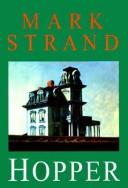Check nearby libraries
Buy this book

Edward Hopper's paintings are icons of American culture. His representations of gas stations, storefronts, cafeterias and hotel rooms embody the solitude of travel and adult life in the America of the thirties, forties and fifties. Because of the familiarity of his subject matter, Hopper has been pigeon-holed both historically, as an American realist, and thematically, as an artist of alienation.
Mark Strand, recent poet laureate and writer of many books of award-winning poetry, approaches Hopper's work with a fresh eye, exploring the aesthetic principles behind the paintings. Strand, whose poems move through a terrain similar to that portrayed by Hopper, possesses a unique and powerful understanding of what makes the paintings so moving and memorable. He writes with his distinctive clarity and grace, examining twenty-three of Hopper's most important works.
He cites aesthetic reasons for Hopper's continuing ability to deeply move people in an America that has grown considerably more complex both politically and socially since mid-century.
Check nearby libraries
Buy this book

Previews available in: English
People
Edward Hopper (1882-1967)| Edition | Availability |
|---|---|
| 1 |
zzzz
Libraries near you:
WorldCat
|
| 2 |
zzzz
Libraries near you:
WorldCat
|
| 3 |
zzzz
Libraries near you:
WorldCat
|
| 4 |
zzzz
Libraries near you:
WorldCat
|
| 5 |
zzzz
Libraries near you:
WorldCat
|
| 6 |
aaaa
Libraries near you:
WorldCat
|
Book Details
Edition Notes
Classifications
The Physical Object
ID Numbers
Community Reviews (0)
Feedback?| July 24, 2024 | Edited by MARC Bot | import existing book |
| December 25, 2021 | Edited by ImportBot | import existing book |
| July 22, 2019 | Edited by MARC Bot | remove fake subjects |
| May 13, 2019 | Edited by MARC Bot | import existing book |
| October 13, 2009 | Created by WorkBot | create work page |















